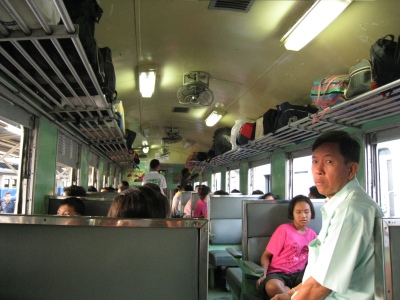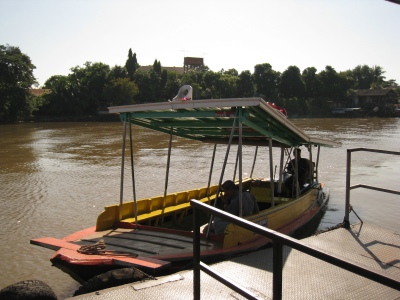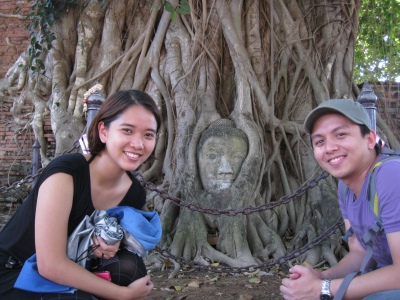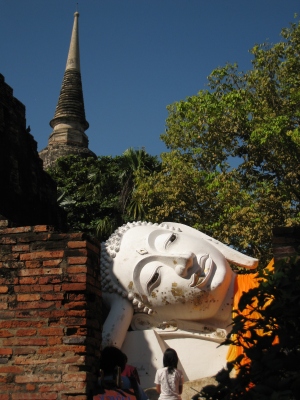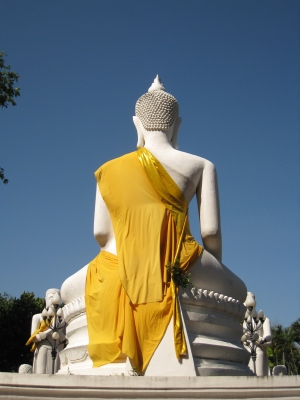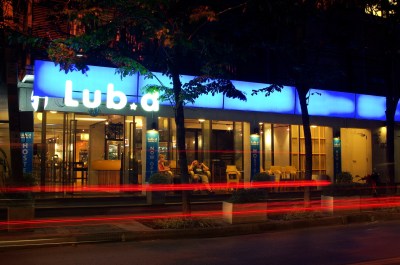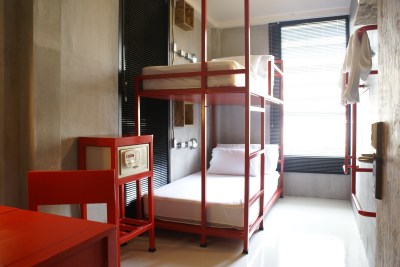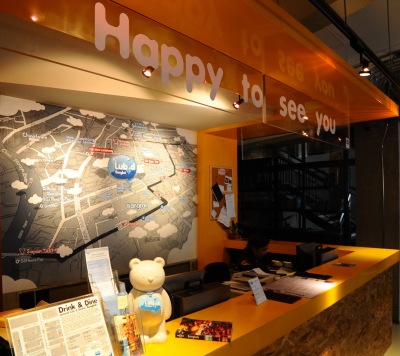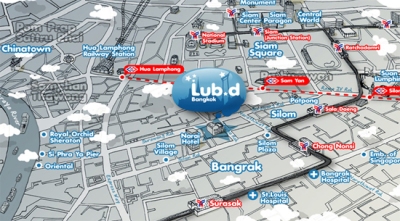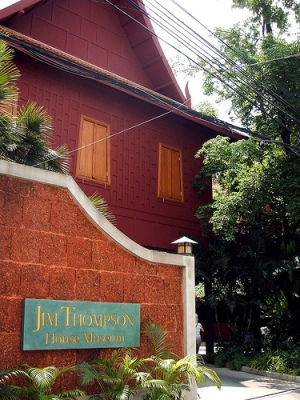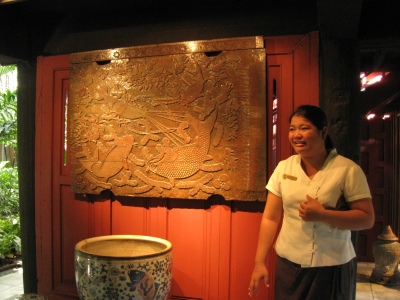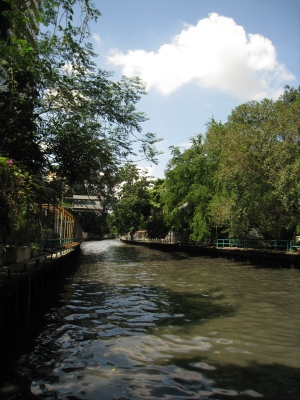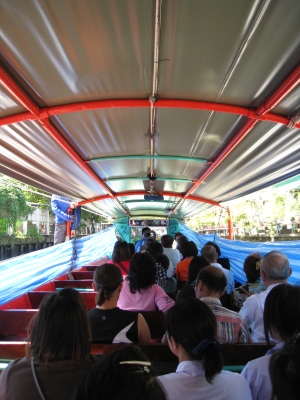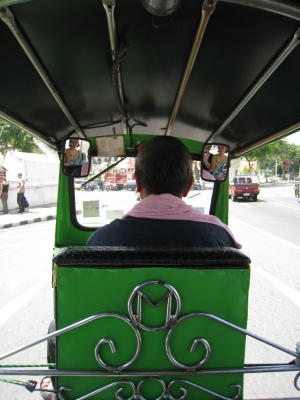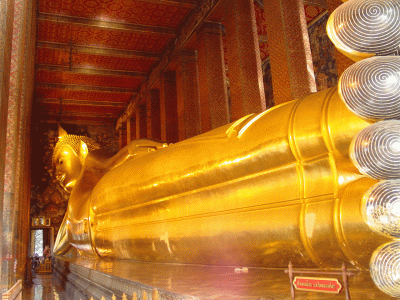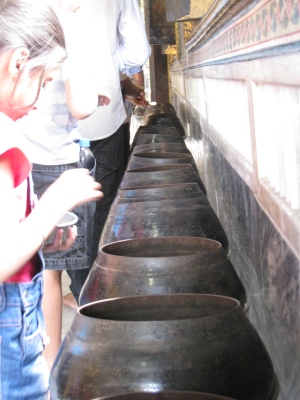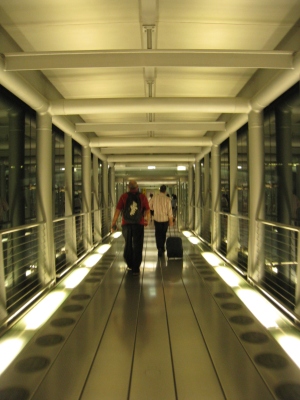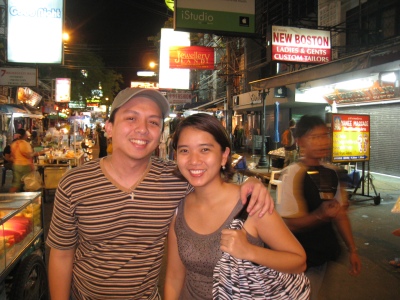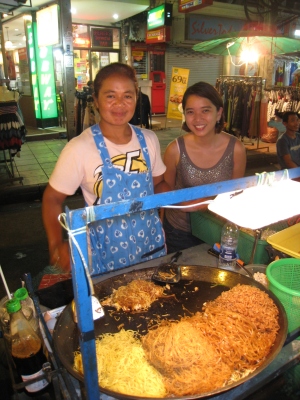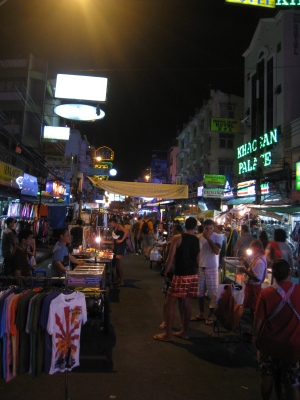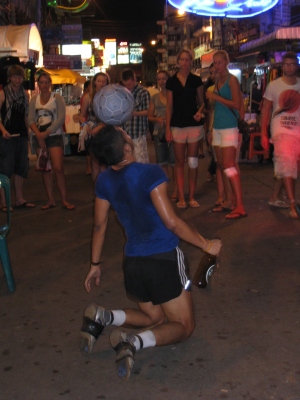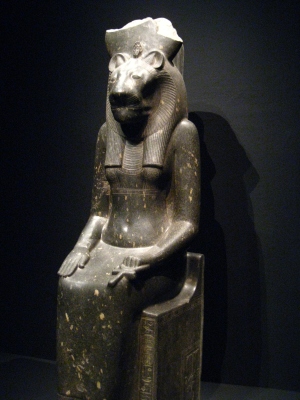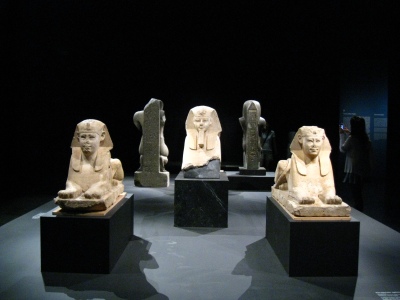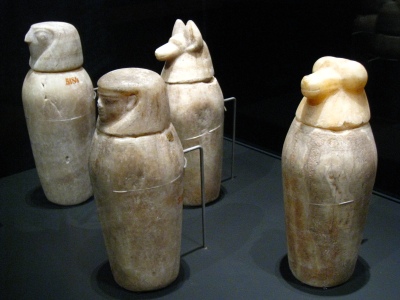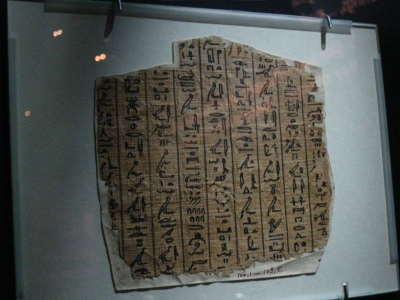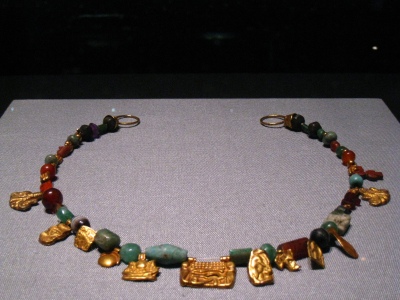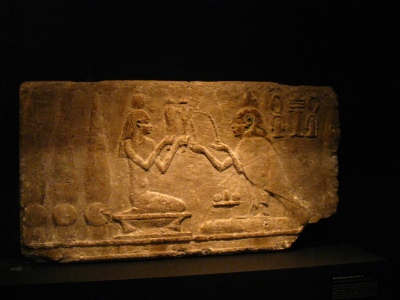A Short Day Trip to Ayutthaya
12 April 2010
The last full day in Bangkok was spent exploring Ayutthaya. The city which was founded in the 13th century was the second capital of Siam (ancient name for Thailand). The ideal location (close proximity to India, China and the Malayan archipelago) made it a financial powerhouse in Asia during its glory days in the 17th century. Records have it that the 1700s, the population of the city has swelled to a million; this made Ayutthaya the largest city in the world in terms of people. All of this glory and grandeur came to a halt when the Burmese invaded the city in 1767 and subsequently burned it down.
Today, this city is a popular day-trip destination from Bangkok. Remnants of temples, palaces and Buddha statues still exist for tourist to get a glimpse of the glorious past of the city. UNESCO formally recognizes the great cultural value of the ancient city’s ruins when it named Ayutthaya as a UNESCO World Heritage Site in 1991.
A lot of travel agencies offer day tours going to Ayutthaya; they usually charge something like at least 1,000 BHT. We did it much cheaper by doing a DIY trip. At around 5:30 that morning, we headed out of our hostel and headed to Hualamphong Train Station where we will be taking a 3rd class train going to Ayutthaya. The ticket costing just 20 BHT was the best way to see the countryside near the outskirt of the city. Apart from being dirt cheap, it was a great way to get a glimpse of the life of ordinary Thais. The ride had multiple stops along the way and about an hour later, we arrived in our stop.
From the train station, we walked around two hundred meters to reach the riverbanks. A boat was there to ferry people to and from the main island of Ayutthaya (where the ruins are found) – this is not free but you only pay around 5 BHT for the two minute crossing.
Across the river, there were several guesthouses that offered bikes for rental. In Ayutthaya, a good way of exploring the place is to rent a bike and just roam around with your map – not on that day though, we gave up on the biking option as then temperature was probably in the mid 30’s (Celsius). A friendly songthaew driver approached us and offered his service at 400 BHT/hour, I was able to haggle it down to 1,000 BHT for a four hour excursion.
We then started our brief Ayutthaya excursion; I could not exactly remember the names of the temples we visited except for Wat Phra Mahathat in which the famous tree that grew around a Buddha head can be found. It was not too spectacular but I was glad to have finally seen in person the artifact which I always associate Ayutthaya with.
The temples have individual entrance fees (although some are free as well) for foreigners, this ranges from 20-50 BHT per person. If you can pass for a local, you might be able to get in for free. Coming from someone who has been to Siem Reap twice, the ruins in Ayutthaya was not so spectacular anymore. It is more or less, “same same but different”
The temperature did not cooperate; in fact it became even hotter after we visited Wat Phra Mahathat. It was then that we decided to head back to Bangkok. Luckily there was a bus that goes straight to the Mochit Terminal in Bangkok; the fare was less than 100 BHT. We paid for it and grabbed the last two remaining seats. I could not remember how long the ride took as I was already asleep as soon as I sat on the air-conditioned bus and only woke up when we arrived in our destination.
Ayutthaya is a stunning place to visit if you want see what was left of the ancient Siam capital. However, the place may not have a huge awe-impact to you if you have previously visited Angkor Wat in Cambodia previously. My suggestion is that if you have a limited time and you have previously visited (or is planning to visit) Siem Reap, skip Ayutthaya and look for other options to do while in Bangkok. Otherwise, go ahead and visit Ayutthaya and do not miss Wat Phra Mahathat. If you plan to do it on the cheap, it would be best to have at least four people in the group so as to share expenses should you ever want to hire a songthaew or tuktuk.
Lub d Bangkok in Silom
29 March 2010
One of the many reasons why I wanted to go back to Bangkok is to set my foot once more in Lab d Bangkok Hostel in Silom Road. Yep, you got me right here, I wanted to go back in order to sleep in a hostel.
I have been here previously during a short backpacking trip with college buddies back in 2008 and I must say that I was really very impressed with our accommodation even if we were book then in the dormitory. Back then it was fairly new and as was expected of all new establishments, it was all neat and clean. When I stepped back inside this hostel (more than 2 years after the first visit), I was very amazed that it still looks very much as clean and neat as how I remembered it.
This relatively new hostel is supposedly designed by one of the most regarded designers in Thailand. Amongst the accommodations to choose from are eight-bed mixed dormitories, a ladies-only dormitory, and a private dormitory for 1-2 people (this means no attached bathroom). It would be good to note that the bathrooms are very clean (I reckon it is cleaned several times a day) and has separate ones for male and female. Of course apart from the dormitories, there are the normal double rooms with attached toilet; these are located in the 4th floor. Unfortunately there are no elevators going up, I suppose they did this purposely for guest to burn off calories coming in from the delicious food all over the city.
The lobby of this hostel is a great place to simply hang out and meet new friends. If you are not the sociable kind, there are several computers in the lobby for you to connect with friends back home and rave about the grasshopper you just ate at the end of Khao San Road. Oh yeah, I forgot to mention that they have high speed internet access even in the rooms; when I say high speed, I mean high speed – enough for me to download a copy of The Beach overnight.
A library is also available at the lobby which contained several guidebooks for the countries in the Southeast Asian region as well as some reference on Thailand. The in-house travel agent is available if in case DIY tour is not your cup of tea. I have to commend the people manning the travel agents and the front desk as they are very helpful in all my questions regarding directions.
Location wise, I would say it is good since it is located in the quiet part of the city – Decho Road to be exact, just off Silom Road (which some people say it is the heart of Bangkok City). A 10-minute walk is all you need to be in the Chong Nonsee station of the BTS sky train, from there you will be connected to most of the major districts in Bangkok. Further down is the infamous Patpong area, home of the famous night market, the red light district and a whole bunch of kathoey.
Pricewise, I would have to be very honest though that it is a bit on the higher end of the scale for a budget traveler. The good thing though is that they have regular promotions every once in a while (like for us, we for buy 2 nights and get the 3rd night free), you just have to check regularly their website or HostelWorld for it.
One may wonder the meaning behind the name, I just learned that Lub D is a Thai word for “sleep well” – truly apt I should say, and that is one coming from a person who just slept most of the time for this particular Bangkok adventure. I heard from the manager, Piyawee, that they will be opening a new branch in Bangkok soon. Now this is something to look forward to and I hope it will already be open when I next visit the City of Angels.
Lub d, Bangkok
4 Decho Road, Silom Area
Suriyawong Bangrak
Bangkok 10500, Thailand
Tel: + 66 (0) 2 634 7999
Fax: +66 (0) 2 634 7510
e-mail: contactus@lubd.com
Paying Respect to JT and the Reclining Buddha
28 March 2010
Our second day in Bangkok started quite early; we managed to get up before 8 in the morning and headed down to the lobby of our hostel. Breakfast there (consisting of bread, fruits and coffee) was quite expensive (200 BHT if I remember it correctly) – this was why we bought instant noodles the previous night in Khao San Road. The staffs didn’t have a problem giving us hot water for our noodles. As a return gesture, I ordered myself some freshly brewed coffee. We spent at least half an hour in the lobby, eating, checking mail and asking with the hotel staffs regarding direction of places we wanted to visit.
It was almost 9 in the morning when we were finally out of our hostel; this will be a very quick day as we are supposed to be back in the hostel at around 1PM as Babes will be joining a half day cooking lesson in the afternoon somewhere in Bangkok. At that time we were very low on cash as we have spent the small amount of BHTs we bought at the airport. One money changer to another, they were all closed as it was still relatively still early in the morning. I was already computing the ridiculously low exchange rate and the exorbitant transaction fee if and when I would withdraw from the local ATM machine as a last resort. Luckily, we saw a money changer just very near our nearest BTS station and the rate was much better than that of the airport.
With our money purses replenished, we boarded the BTS from Chong Nonsee to the National Stadium. In Bangkok, the trains plying the city (BTS and MRT) are very efficient and very clean as well. I used to be confused with the difference between the BTS and MRT; it was only recently that I learned that the BTS is for the an elevated rapid transit system in Bangkok while the MRT is an underground metro system of the city. Tickets are sold at vending machines near the turnstile and are operated using coins; if you don’t have enough coins with you, there is a counter that will always be there to exchange your bills with coins.
Four stations and less than 10 minutes later, we alighted at our destination and slowly walked our way towards our first destination, The Jim Thompson House (admission at 100 BHT for adult) – for starters and for those who do not know this person, JT was a former U.S. military intelligence officer who helped revitalized the Thai silk and textile industry. He is also famous for disappearing mysteriously while going for an Easter Sunday walk in Cameron Highlands in Malaysia.
JT’s house in Bangkok was converted into a beautifully preserved museum which contains beautiful ancient artifacts from all over ancient Indochina. The compound is composed of six antique Thai houses, most of which were 19th century houses which were originally from Ayutthaya. Accordingly, The Jim Thompson House is the second most visited tourist attraction in Bangkok, surpassed only by the Grand Palace. As we didn’t have time, we opted for the free guided tour that was conducted at least every hour. This gave us a brief overview and appreciation of this attraction.
At around two hours later, we finished our brief tour of JT’s house and started looking our way to the nearest canal to take a river taxi towards our next destination. In order to be very efficient in your time in Bangkok, it is very important to know the routes not just of trains and buses but also river taxis. Since there are numerous canal in and around the city, river taxis has been in existence to make life easier (and faster) for commuters. It is relatively cheap and will really help you escape from the dreaded Bangkok traffic jam.
A quick river taxi and an equally quick tuktuk ride (but more expensive) brought us to the gates of Wat Pho, more famously known as The Temple of the Reclining Buddha. There was someone who greeted us outside the entrance and said that the temple is closed for lunch and instead offered to take us somewhere nearby which we politely declined. My suspicion that is a set-up for a scam was confirmed when several other people came towards us and said the same thing. Fortunately I was able to locate the entrance after a few minutes, paid for our tickets and made our way inside the temple complex.
Wat Pho is one of the largest and oldest wats in Bangkok with an area of around 80,000 square meters. This houses more than a thousand Buddha images, including the famous the Reclining Buddha. The famous religious icon is forty-six meters long and fifteen meters high, with gold plating on the body and mother of pearl on the eyes and the foot soles.
It was very hot during that time as it was already almost noontime (which means time was running out), although the architectures were very nice, all we could think at that very moment was to find our way to the Reclining Buddha. If you have an ample time to spend, it would be nice to explore the various buildings in the complex. Apart from temples, a massage school can be found can be found in the northern part of the compound.
We capped our visit in the temple complex by dropping coins in the money pot at one side of the building that housed the reclining Buddha. For a minimum donation of 20 THB, you will be given 80 coins to drop into the money pot. Apart from the Thai belief of this being auspicious, the dropping of the coin provided a constant “ting” inside the building (for me it provides a relaxing atmosphere).
Shortly, we hailed a cab and headed back to the comfort of our hostel. I parted ways that afternoon with my partner in crime as she went out and tried to learn Thai cooking. I, on the other hand, got myself some light lunch in a stall somewhere in Silom Road. Since it was very hot that day, I retreated to our room where I rested for most of the afternoon and recharged my energy.
Revisiting the City of Angels
21 March 2010
It was sometime during the latter part of last year that I finally got the chance to revisit Bangkok. My first time to be in that wonderful place was in 2008, that was the time when I went on a mini backpacking trip across Bangkok, Siem Reap and Vientianne with some college friends. Admittedly, our schedule (as well as budget) back then was a bit tight which was why I was really very keen on coming back even for just another short visit. An airline sale was all it took for me to revisit the City of Angels. This time, I would want it to be a more relaxed trip.
Just for a start, Bangkok is the capital of Thailand as well as its largest city. It has a population of more than 11 million people which is almost triple that of the Republic of Singapore. This place is certainly very well know around the world for being the mecca of backpackers (more on that later!) and its delicious food.
We left Singapore just before sunset taking a Jetstar flight that took just a little over 2 hours. Despite the fact that it was raining so hard when we landed in Bangkok, it was a fairly quiet flight and I just sat still on my seat for the whole time while reading a copy of the inflight magazine and Alex Garland’s The Beach.
Suvarnabhumi Airport is as stunning as how it was when I first visited. We passed by a lot of shops along the way since the docking bay for our flight was at the extreme end of the airport complex. It took more than five minutes of walking before reaching the immigration gate. As per previous experience, Bangkok immigration officials are not so quick in processing immigration formalities and true enough, it was still the same this time around.
Immediately after clearing Bangkok immigration, we headed to the nearest money changer inside the airport to get our SGDs converted to THBs. It is very important to know the current fx conversion so as to have an idea whether the exchange rates are favorable or not. I was correct in assuming that the rates were not good so I just exchanged enough THBs to cover the taxi fare going to the hostel.
In Bangkok (and maybe all over Thailand), one of the things I really don’t like is the language barrier. Most applicable especially on the taxi drivers, as they have a hard time in understanding or in speaking the English language. A good way of getting around this “Lost in Translation” scenario is to have the name and address of your destination printed out beforehand. Doing it this way should greatly reduce the chances of you being brought to another destination far from where you intent to go. Getting a taxi was not much of a problem, we just headed to the designated counter and paid the “booking fee” and immediately got ourselves a ride going to the city.
The ride going to Decho Road took more than 20 minutes, a very fast one that is since we were using the expressway. The taxi driver dopped us off at the lobby of Lub d Bangkok Hostel. This was also the same accommodation which I used back in 2008. We did a quick check-in (thanks to HostelWorld, we were able to book in advance and was able to avail of a stay 2 night and get the 3rd night free in their private double room) then immediately headed out to find something to eat as we were already starving at past ten in the everning. The initial plan to stay just within the Silom Road area for dinner did not materialize because we did not find any place interesting to eat. It was a weekday then, so I surmise the establishments around the area closed much earlier than their weekend schedule.
I hailed a cab and asked the driver to take up to a place with good food. No such luck as we were “Lost in Translation” – I then decided that we visit visit Khao San Road. There was no problem upon hearing the word Khao San Road, we got there in less than 15 minutes – the infamous traffic of Bangkok was practically none existent that night as it was quiet late already.
This short street in Central Bangkok is world famous and is considered as the gateway to Southeast Asia. It used to be a rice market; the past 20 years however saw it transformed to become a backpacker’s ghetto. Cheap accommodations, travel agencies, pubs, souvenir items, fake Lonely Planet books, cheap food – you name it and definitely you can see it in Khao San Road.
A Pad Thai Noodle stall in the street was too tempting for us and we each got ourselves one serving – at a ridiculously inexpensive price of just 25 Baht. It was prepared right before our very eye; preparation time was less than 2 minutes. Apart from being very cheap, it was simply the best Pad Thai Noodle that I have ever tasted. One thing that is really nice when you visit Bangkok is the plethora of affordable and delicious streetfood that can be found all over the city.
After finishing our food, we continued our stroll along Khao San Road. People from all walks of life were there; some were eating, some were drinking, and some were shopping. Yep, this is also a night market where you can get anything you want that can help you out in your travels – including fake identification cards. 😉
An hour was enough for us to walk and feel the atmosphere of Khao San Road; not the cleanest place in Bangkok but definitely this place has its own charm which can keep you coming back for more. The reason perhaps is because I know for a fact that whenever I am in this area of the world, I am with kindred spirits – a lot of them!
We stopped by a 7-11 store to get some water and noodles (as breakfast is not included in our accommodation) before flagging a pink Toyota taxi that took us back to our hostel.
Quest for Immortality – The World of Ancient Egypt
1 March 2010
I have always been a big fan of the culture of ancient Egypt. It all started when my mom read to me something about the curse of Tutankhamen; that was way back probably around twenty years ago. It was not a hard a hard decision to revisit the National Museum of Singapore one hot Sunday afternoon as they currently house a temporary exhibit about ancient Egypt.
Dubbed as Quest for Immortality – The World of Ancient Egypt, this exhibit offers an insight to how the ancient Egyptians perceived life and the afterlife. The life after death is very important to these ancient civilization and as such it was very important for them to make sure that adequate preparation were done in order to ensure a smooth transition of the dead from his earthly existence to the realm of immortality.
There are more than a hundred priceless artefacts spanning from 4500 BC to 950 BC in the exhibit; these includes statues of gods, jewelleries of the dead and tools for mummification. But perhaps the most interesting artefacts of them all were some real mummies. Yes, there were a couple of them bundled up by thick plaster and displayed. However these are not the grotesque version you may have probably seen in the encyclopaedias; needless to say, it is enough for me to tell myself that I have seen an Egyptian mummy in person myself.
This exhibit is currently ongoing until the 4th of April. The gallery is open from 9AM until 6PM. There is an entrance fee of 15 SGD that applies. Lucky for you if you have a Mastercard as there is a 50% discount to the entrance fee. A free guided tour is conducted everyday at 11:30am and 2:30pm (with an additional tour at 3:30pm every Sunday).
